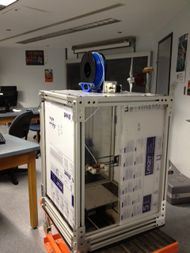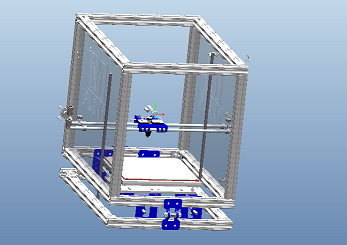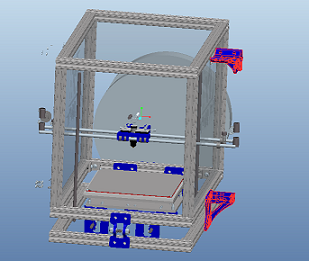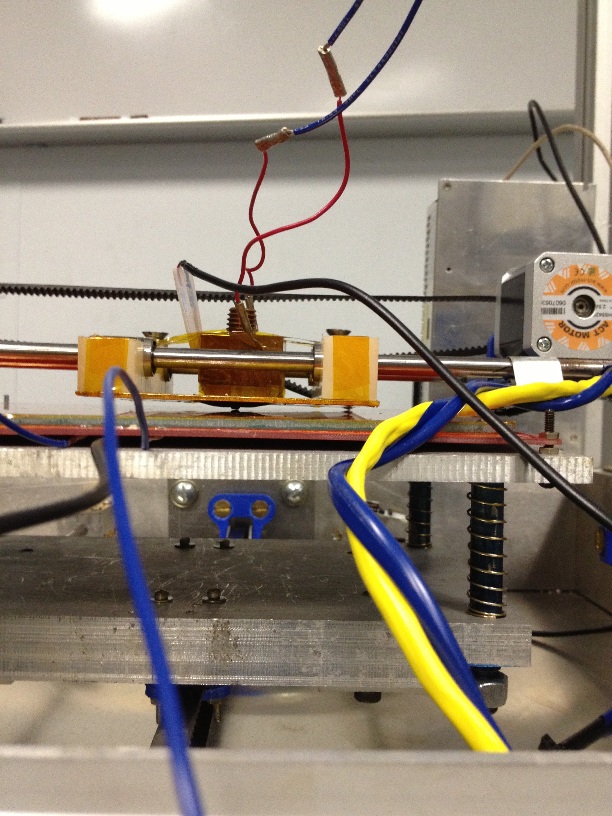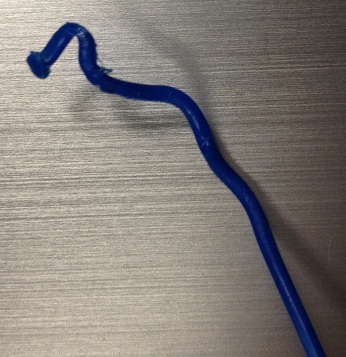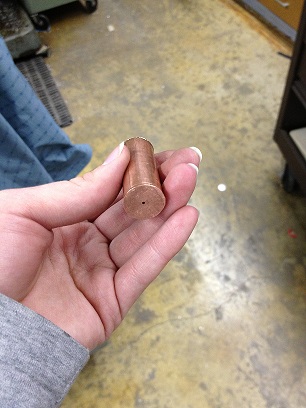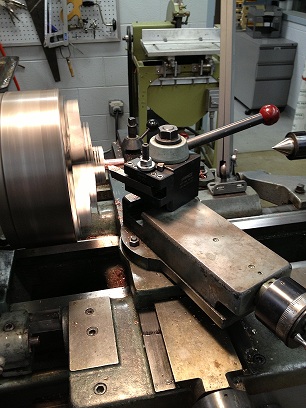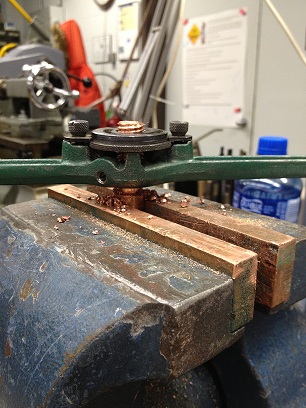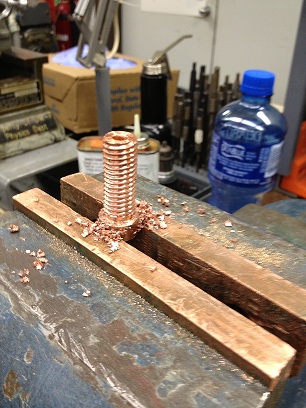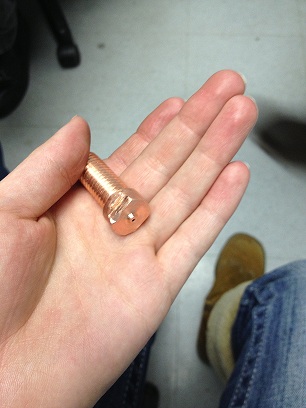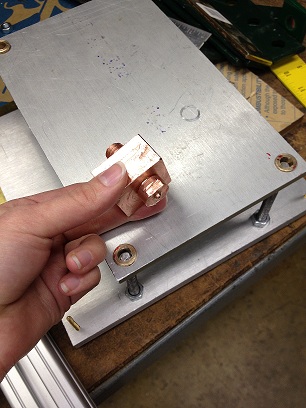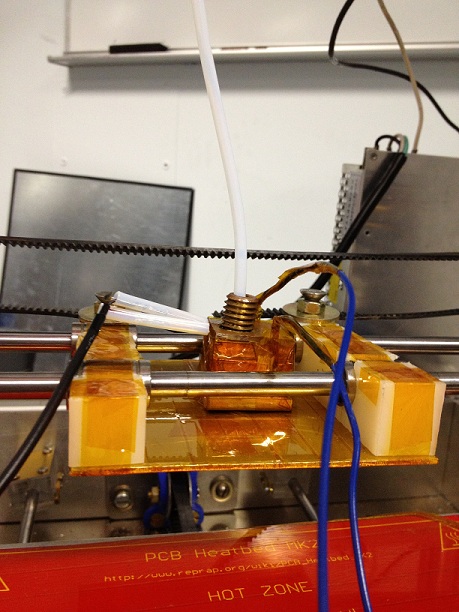BoomBOx
|
English • العربية • български • català • čeština • Deutsch • Ελληνικά • español • فارسی • français • hrvatski • magyar • italiano • română • 日本語 • 한국어 • lietuvių • Nederlands • norsk • polski • português • русский • Türkçe • українська • 中文(中国大陆) • 中文(台灣) • עברית • azərbaycanca • |
Release status: experimental
| Description | beastly child of Prusa Air and Mendel Max
|
| License | |
| Author | |
| Contributors | |
| Based-on | |
| Categories | |
| CAD Models | |
| External Link |
 <videoflash>iqUPxjismV0</videoflash>
<videoflash>iqUPxjismV0</videoflash>
Introduction
BoomBOx stands 2 feet tall, with a standard 8x8 inch printbed. The name "BoomBOx" was coined in the reprap IRC after various instances of the LCD screen screaming on google hangout. BoomBox is in the final stages of the build and has yet to get 'wet'.
Designed within the 6 months of research completed on reprap 3D printers, the goal of BoomBOx was to adapt to great ideas and make improvements along the way. The BoomBOx extruder was inspired by the removable nozzle of the JHead extruder. The BB extruder head is longer than the JHead tip and less likely to come loose during print. Like the JHead, the BB extruder has a peek block for the resistor. The BoomBOx extruder is a solid copper extruder. With a relatively large peek block, extrusions should be fairly smooth after preheat.
The BoomBOx printer has made only slight changes to the design of the MendelMax printbed and BB also uses MendelMax printed parts. Using the GRABCAD MendelMax model, BoomBOx was designed in CAD assembly mode. One of the great changes in the BoomBOx printer are the advent of inverted X and Z axes. The printer is fully encased along the bottom of the machine and the encasement allows smooth rod to escape into a pressure hold between the frame (precisely placed holes drilled into steel).
The bowden for the BoomBOx was inspired by the hobbed bolt of Gregs extruder. Designed by the engineering technician at the University of Michigan Flint(UMF), the BB bowden features a rollerbearing with a grove. The bowden has adjustable spring pressure support and uses a hobbed gear to feed filament into the PTFE tubing.
BoomBOx creators are currently in the process of constructing the full CAD model. To save on time, many changes to the machine were done on the spot. The inverted axis and the metal encasement y axis system has yet to be sketched into Creo.
History
Amanda Korant, an engineering student at the University of Michigan Flint, built BoomBOx as part of a research grant she received in Fall of 2012. BoomBOx was a team effort, with participation from the UMF engineering club; even during finals week. The grant project started with materials research and major design changes. As students showed interest in a MendelMax model, Amanda kept a Prusa design in mind and opened the frame to a wider stance.
With schedule changes of winter semester, many club members became unavailable. The engineering technician John O’Brien became especially helpful and gave much of his time to BoomBOx construction.
BoomBOx is different, with backwards motors and upside down axis; this printer was created custom. Even when ideas seemed impractical, they were worked out once creativity became apparent. With the BoomBOx design, sheet metal and polycarbonate (Lexan) are introduced to the frame. The environment can be heated or fumigated as desired. The visual exposure of Prusa and structural rigidity of Mendel is not only stellar- it is BEAST. Looming over the machine shop, rolled around on a cart- it is over 3 times the height of the MendelMax printer.
LoM List of Materials
Bearings
Qt.10 - LM8UU (Asia) or LME8UU (US, Europe) linear bearings OR 8mmx25mm brass bushings -$12.52+shipping
Qt.5 - 608 "roller skate" bearings "6082RS" for sealed, "608ZZ" for shielded.-$25.50+shipping (est $12.70)
M8 threaded Rods
(can all be cut from 6 1m lengths of M8 threaded rod, Amazon - $37.14)
Qt.6 - 370mm M8 threaded rod Three per side
Qt.4 - 294mm M8 threaded rod Front/rear. Can use 300mm too
Qt.3 - 440mm M8 threaded rod Top/Bottom. Can use 450m too
Qt.2 - 210mm M8 threaded rod z-axis lead screws. Can use 300mm too
Qt.6 - 405mm M8 smooth rod
Bed
Qt.2 slabs of metal
Qt.4 springs
Qt.4 extra pieces of threaded rod
Qt.4 brass bushings
Belts, eBay
Qt.1 - 840mm GT2 toothed belt, matching pulleys Gates Corp.
Qt.1 - 900mm+ GT3 toothed belt, matching pulleys Gates Corp.
Qt.2 - 16-tooth matching GT2 pulleys bore dia. 5mm Gates Corp.
Qt.2 - - 16-tooth matching GT3 pulleys bore dia. 5mm Gates Corp.
(GT2 belt advised if long enough, 16 or 12 tooth pulley- 16 advised)
Filament
1 3mm ABS/PLA roll - $42 per roll + $12.60 shipping = $57.12 (Protoparadigm LLC)
Wire - Amazon
Qt.1 12AWG THHN stranded wire 8ft $18.51+ shipping (est. $12.70)
Motors
5 NEMA 17 Stepper Motor 40N/m $68 + $33 shipping = $105.08
Plates
Qt.1 Heatbed MK1 PCB $31.79 + shipping (est. $20) ebay
Qt.1 8x8 in glass plate estimated $3
Extruder
- BoomBOt extruder custom made by in a machine shop
Qt.1 Hot end $63.59 + shipping (est.$20)
Qt.1 High Heat Braided wire McMaster Part No. 8209K11 (or equivalent)- $1.31 +shipping (est. $13)
Qt.1 Teflon (PTFE) sleeve (2 feet) for thermistor lead insulation and filament tube McMaster Part No. 5335k11 (or equivalent)
Qt.1 Kapton tape roll for thermistor mounting
Plastic Parts
Mendel Max Parts kit
Frame
Qt.4 8-foot, 1.5 inch aluminum extrusions
Qt.50 M8 screws (½-20), 20mm length
Qt.1 4ftx4ft sheet of plexi/lexan for the encasing
Qt.2 Sheet metal for the backing and the bottom of the machine (we use sheet on back, steel on bottom)
Electronics
Qt.1 ATMEGA2560 with RAMPS 1.4 (original) or ATMEGA328P Board + USB $18 + free shipping
Qt.1 H-bridge for Z Stepper Motors $5.17 + free shipping (not included in original build)
Area
Qt.1 Machine Shop with a mill, lathe, band saw, and 1 large cart
Total Estimated Cost: $850
DIY Extruder
Do it yourself BoomBOx extruder build
WARNING: EXPERIMENTAL
LoM
Qt.1 Chunk of copper (small) [2.5 by 2 cm only goes up to about 159 C]
Qt.1 Section of copper rod
Instructions
- Keep in mind to build the extruder before you build the x-carriage
1) Take about a 3.5 inch length of copper rod, drill a 1mm hole in it.
NO PICTURE AVAILABLE
2) Take a drill bit a little bigger than your PTFE tubing and drill over the hole. Drill down until there is about 1.5-2cm left for the head on the bottom.
3) Use a lathe to shave the nozzle down towards the hole, but not touching the hole- therefore, creating a 'nozzle'. This nozzle will not be like a cone. More...think of a little piece of the straw sticking out of your soft drink. Try to lathe about 1mm away from the hole and move down about 2mm, to create a 1mm long tip. Move VERY SLOWLY with copper. VERY VERY SLOWLY
4) Flip the rod piece in the lathe with only 1.5-2cm inside of the lathe, nozzle facing inward. Now shave the length of the rod down.
5) Take the extruder piece out and place it in a copper clamp.
6) If you have decided on threads for your peak block, thread the extruder accordingly. I think we used 2/3 threads- in any case, they should be large.
NO PICTURE AVAILABLE
7) Cut/prepare your peek block accordingly with a drilled hole and threads for the extruder.
8) The fun part- if you can't thread straight, you may have to stick the head back into the lathe and turn the lathe to get the peek block on. Warning: this may take three people to do
9) Drill a hole smaller than your resistor into the block.
10) Drill a hole the size of your resistor a little more than halfway into your block. This lets the resistor rest there without having a way to coming out from the other side. You're done!
---Pop off the top and put Prusa in the box; Mendusa was born.---
--Amanda Korant 04:46, 16 August 2013 (UTC)
